Study on Dynamic Mechanical Properties and Failure Pattern of Thin-Layered Schist
Abstract
:1. Introduction
2. SHPB Test
2.1. Specimen Preparation
2.2. Test Equipment
3. Dynamic Mechanical Properties
3.1. Stress Balance
3.2. Characteristics of Stress–Strain and Dynamic Strength
3.3. Energy Dissipation Law
4. Numerical Simulation
4.1. Model and Parameters
4.2. Fracture Process
5. Discussion
5.1. Influence of Schistosity Angle
5.2. Influence of Schistosity Spacing
6. Conclusions
- (1)
- The stress–strain curves of thin-layered schist with different schistosity angles are similar, and there are several significant stages in the curve under transient loading, including the elastic compression stage, plastic deformation stage and strain softening stage. The dynamic critical failure strength of each thin-layered schist conforms to the typical anisotropy characteristics of “U”-type strength.
- (2)
- For specimens with schistosity angles of 0°and 90°, the main failure patterns are, respectively, axial splitting failure and splitting failure along the schistosity plane. In the case of thin-layered schists with other schistosity angles, it is observed that the main failure pattern is significant shear failure, accompanied by local compression/shear composite failure characteristics.
- (3)
- With the decrease in schistosity spacing, the main failure pattern of thin-layered schist is significant shear failure; the damage degree of rock specimens is higher and more radial cracks are generated. In addition, the dynamic compressive strength decreases gradually and its value drops by up to 20.3% from the schistosity spacing of 22 mm to 7 mm.
Author Contributions
Funding
Institutional Review Board Statement
Informed Consent Statement
Data Availability Statement
Conflicts of Interest
List of Symbols
| Θ | schistosity angle |
| WI, WR and WT | incident energy, reflection energy and transmission energy |
| Ws | dissipated energy |
| E0, A0 and C0 | elastic modulus, cross-sectional area and elastic wave velocity of the impact pressure bar |
| εI, εR and εT | incident, reflected and transmitted strain |
| ρ | density |
| E | elastic modulus |
| Ν | Poisson’s ratio |
| σ* = σ/fc | normalized equivalent yield strength |
| σ | Equivalent strength |
| fc | quasi-static uniaxial compressive strength |
| A | normalized viscous strength |
| B | normalized pressure hardening coefficient |
| C | influence coefficient of strain rate |
| D | damage degree |
| N | pressure hardening coefficient |
| P* | dimensionless pressure |
| ε* | dimensionless strain rate |
References
- Yin, X.; Yan, E.; Wang, L. Anisotropy of quartz mica schist based on quantitative extraction of fabric information. Bull. Eng. Geol. Environ. 2020, 79, 2439–2456. [Google Scholar] [CrossRef]
- Liu, Y.; He, C.; Wang, S.; Peng, Y.; Lei, Y. Dynamic Splitting Tensile Properties and Failure Mechanism of Layered Slate. Adv. Civ. Eng. 2020, 2020, 1073608. [Google Scholar] [CrossRef]
- Zheng, Y.; Zhang, T.; Yang, H.; Wang, W.; Niu, Q.; Wei, H. An Experimental investigation on mechanical properties and failure characteristics of layered rock mass. Appl. Sci. 2023, 13, 7537. [Google Scholar] [CrossRef]
- Shuang, G.; Zhen, W.; Lei, Z. Dynamic fracture mechanics and energy distribution rate response characteristics of coal containing bedding structure. PLoS ONE 2021, 16, e0247908. [Google Scholar]
- Villalobos, F.A.; Rodriguez, P.A.; Vera, M. Study of the anisotropic tensile and compressive strength of a foliated phyllite. Proc. Inst. Civ. Eng. Geotech. Eng. 2021, 176, 15–26. [Google Scholar] [CrossRef]
- Kou, B.; Zhang, D.; Meng, T. Micro and macro evaluation of tensile characteristics of anisotropic rock mass after high temperatures treatment-a case study of Lingshi Gneiss. Geothermics 2022, 102, 102409. [Google Scholar] [CrossRef]
- Mo, Y.; Zuo, S.; Wang, L. Mechanical characteristics of thick-bedded limestone with different bedding angles subjected to acid corrosion. Bull. Eng. Geol. Environ. 2022, 81, 166. [Google Scholar] [CrossRef]
- Shi, X.; Zhao, Y.; Danesh, N. Role of bedding plane in the relationship between Mode-I fracture toughness and tensile strength of shale. Bull. Eng. Geol. Environ. 2022, 81, 81. [Google Scholar] [CrossRef]
- Nezhad, M.; Fisher, Q. Experimental study and numerical modeling of fracture propagation in shale rocks during Brazilian disk test. Rock. Mech. Rock. Eng. 2018, 51, 1755–1775. [Google Scholar] [CrossRef]
- Tien, Y.; Kuo, M. A failure criterion for transversely isotropic rocks. Int. J. Rock Mech. Min. Sci. 2001, 38, 399–412. [Google Scholar] [CrossRef]
- Li, Y.; Zhao, B.; Yang, J.; Sun, J.; Huang, W.; Li, Z.; Wang, B. Experimental study on the influence of confining pressure and bedding angles on mechanical properties in coal. Minerals 2022, 12, 345. [Google Scholar] [CrossRef]
- Qiu, J.; Li, D.; Li, X. Dynamic failure of a phyllite with a low degree of metamorphism under impact Brazilian test. Int. J. Rock Mech. Min. Sci. 2017, 94, 10–17. [Google Scholar] [CrossRef]
- Zhao, Y.; Liu, S.; Jiang, Y.; Wang, K.; Huang, Y. Dynamic tensile strength of coal under dry and saturated conditions. Rock Mech. Rock Eng. 2015, 49, 1709–1720. [Google Scholar] [CrossRef]
- Feng, J.; Wang, E.; Chen, X.; Ding, H. Energy dissipation rate: An indicator of coal deformation and failure under static and dynamic compressive loads. Int. J. Min. Sci. Technol. 2018, 28, 397–406. [Google Scholar] [CrossRef]
- Fan, X.; Luo, N.; Liang, H.; Sun, X.; Zhai, C.; Xie, L. Dynamic Breakage Characteristics of Shale with Different Bedding Angles under the Different Ambient Temperatures. Rock Mech. Rock Eng. 2021, 54, 3245–3261. [Google Scholar] [CrossRef]
- Liu, G.; Peng, Y.; Zuo, Q.; Su, Y.; Wu, L. Dynamic mechanics and energy dissipation of saturated layered phyllite. Minerals 2022, 12, 1246. [Google Scholar] [CrossRef]
- Luo, N.; Zhang, H.; Chai, Y.; Li, P.; Zhai, C.; Zhou, J.; Ma, T. Research on damage failure mechanism and dynamic mechanical behavior of layered shale with different angles under confining pressure. Deep Undergr. Sci. Eng. 2023, 2, 337–345. [Google Scholar] [CrossRef]
- Calmels, F.; Coutard, J. Laboratory experiment on Frost creep mobilization of a heterometric schistous slope. Permafrost. Periglac. 2000, 11, 207–218. [Google Scholar] [CrossRef]
- Zuo, Y.; Han, L.; Hu, H.; Luo, S.; Zhang, Y.; Chen, X. Visco-elastic–Plastic Creep Constitutive Relation of Tunnels. Soft Schist. Geotech. Geol. Eng. 2018, 36, 389–400. [Google Scholar] [CrossRef]
- Xu, J.; Chen, J.; Jiang, P. Investigation of creep behaviors of wudang mica schist by triaxial compression tests. Geotech. Geol. Eng. 2019, 37, 3831–3842. [Google Scholar] [CrossRef]
- Yin, X.; Xia, Z.; Lei, Y. Effect of loading direction on the critical characteristic strength and energy evolution of quartz mica schist and microscale mechanisms. Bull. Eng. Geol. Environ. 2021, 80, 8693–8710. [Google Scholar] [CrossRef]
- Zuo, J.; Wu, L.; Zuo, J.; Lu, L. Study on the constitutive model of visco-elasticity-plasticity considering the rheology of rock mass. Adv. Mater. Res. 2013, 2195, 567–572. [Google Scholar]
- Zhou, Y.; Su, S.; Chen, J. Dynamic response characteristics of dry and water-saturated schist under impact loading. J. Mt. Sci. 2020, 17, 3123–3136. [Google Scholar] [CrossRef]
- Mehmet, Ö.; Sunay, B.; Kaan, E. The effect of anisotropy on the dynamic properties of schist rocks. J. Sci. Rep. A 2022, 49, 92–104. [Google Scholar]
- Liu, S.; Xu, J. Experimental and numerical analysis of Qinling mountain engineered rocks during pulse-shaped SHPB test. Int. J. Nonlinear Sci. Numer. Simul. 2015, 16, 165–171. [Google Scholar] [CrossRef]
- Feng, P.; Liu, B.; Tang, R.; Wei, M.; Zhang, Y.; Li, H. Dynamic fracture behaviors and fragment characteristics of pre-compressed flawed sandstones. Int. J. Mech. Sci. 2022, 220, 107162. [Google Scholar] [CrossRef]
- Ping, Q.; Ma, Q.; Yuan, P. Energy dissipation analysis of stone specimens in SHPB tensile test. J. Min. Saf. Eng. 2013, 30, 401. [Google Scholar]
- Wang, J.; Wang, S.; Chen, Z.; Zou, Y.; Cao, W.; Zhou, J.; Li, C. Influence of inclined joint on dynamic response of rectangular opening subject to blast-induced stress wave. Arab. J. Sci. Eng. 2024. [Google Scholar] [CrossRef]
- Fan, Y.; Chen, J.; Leng, Z.; Yang, G.; Liu, X.; Tian, B. Punching mechanism of air-deck stemming for drilling blasting and its influence on rock fragmentation. Rock. Mech. Rock. Eng. 2024, 57, 3917–3935. [Google Scholar] [CrossRef]
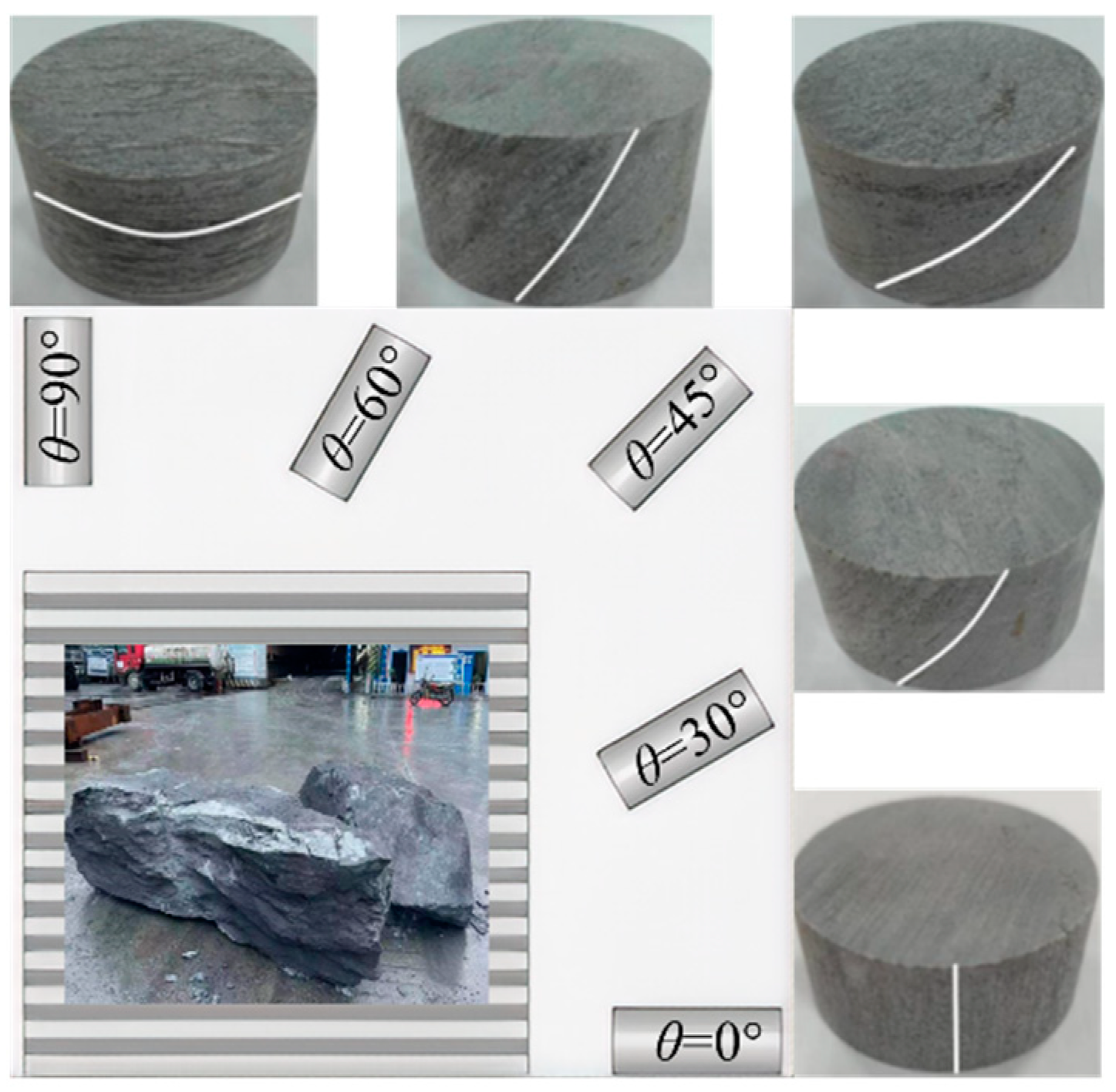
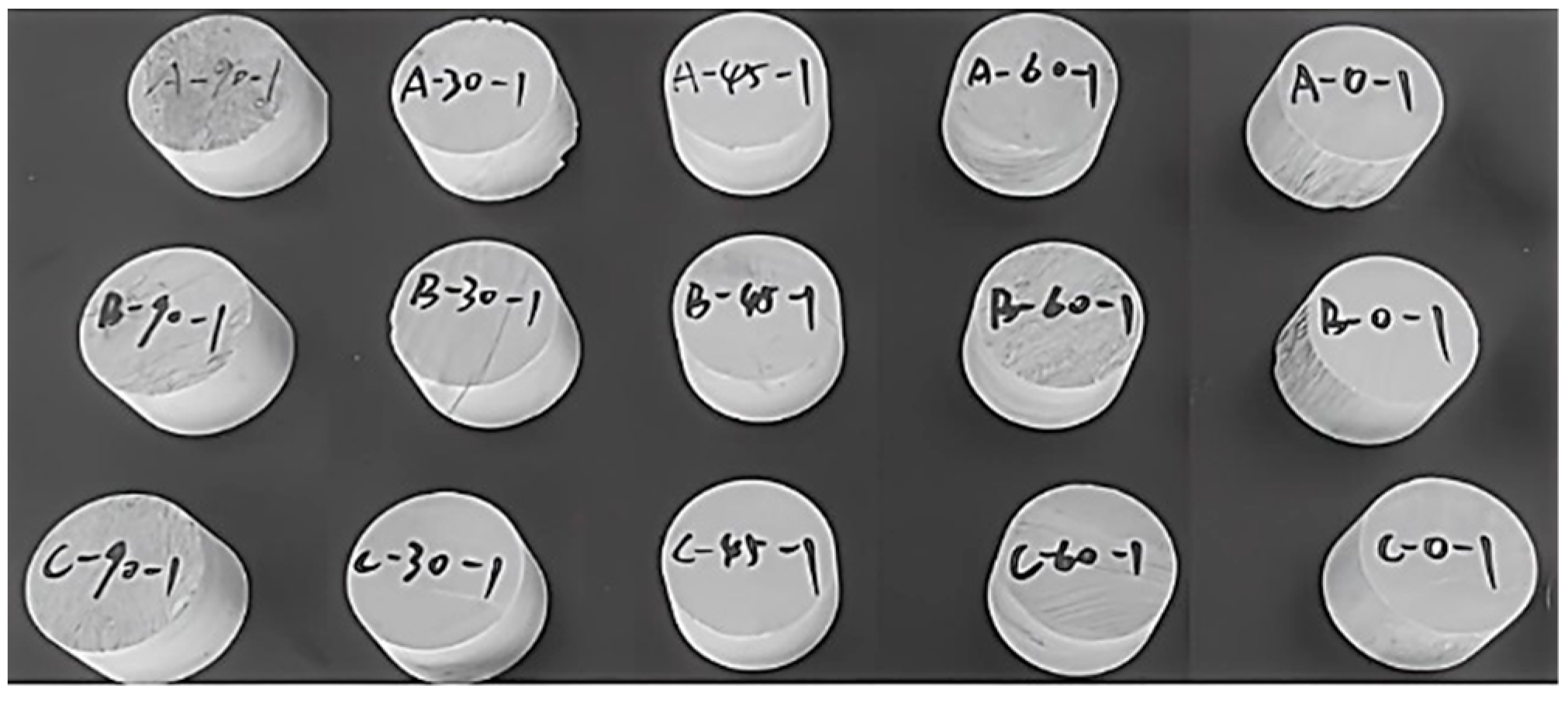
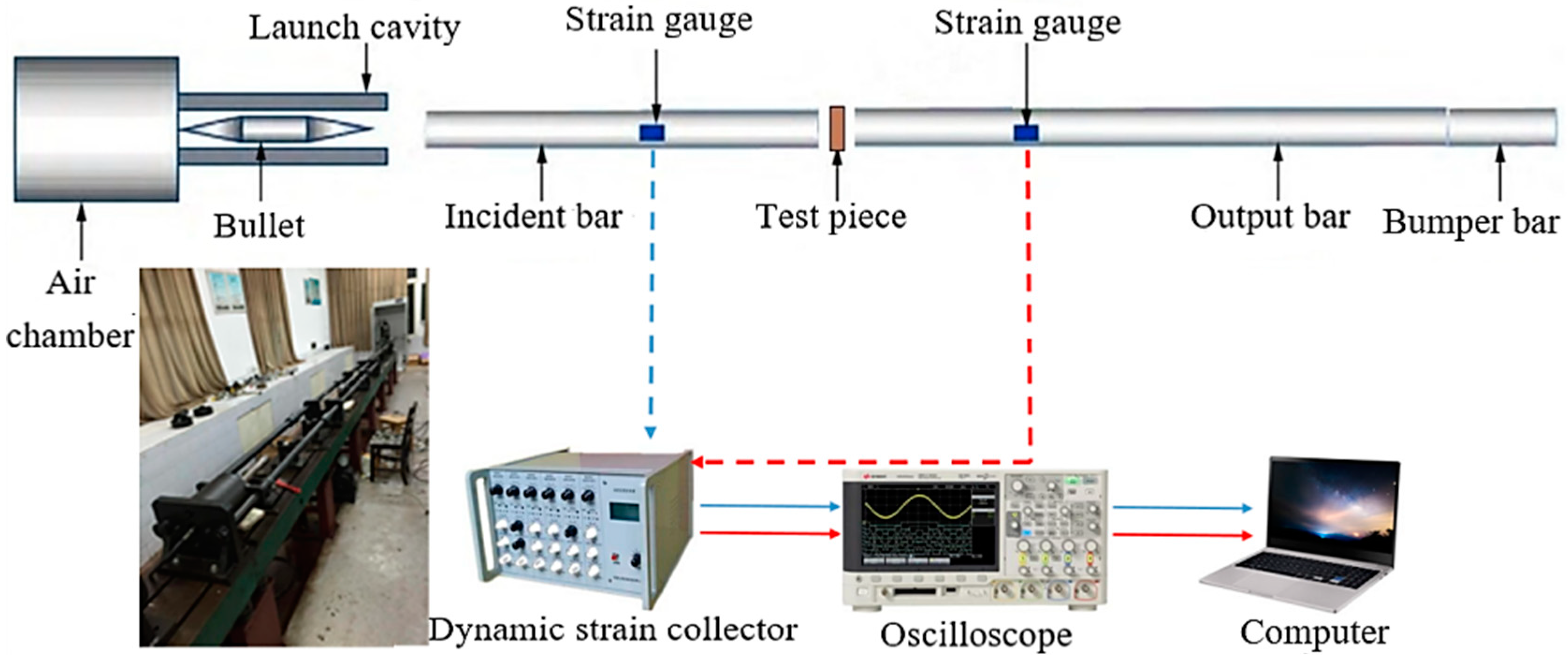


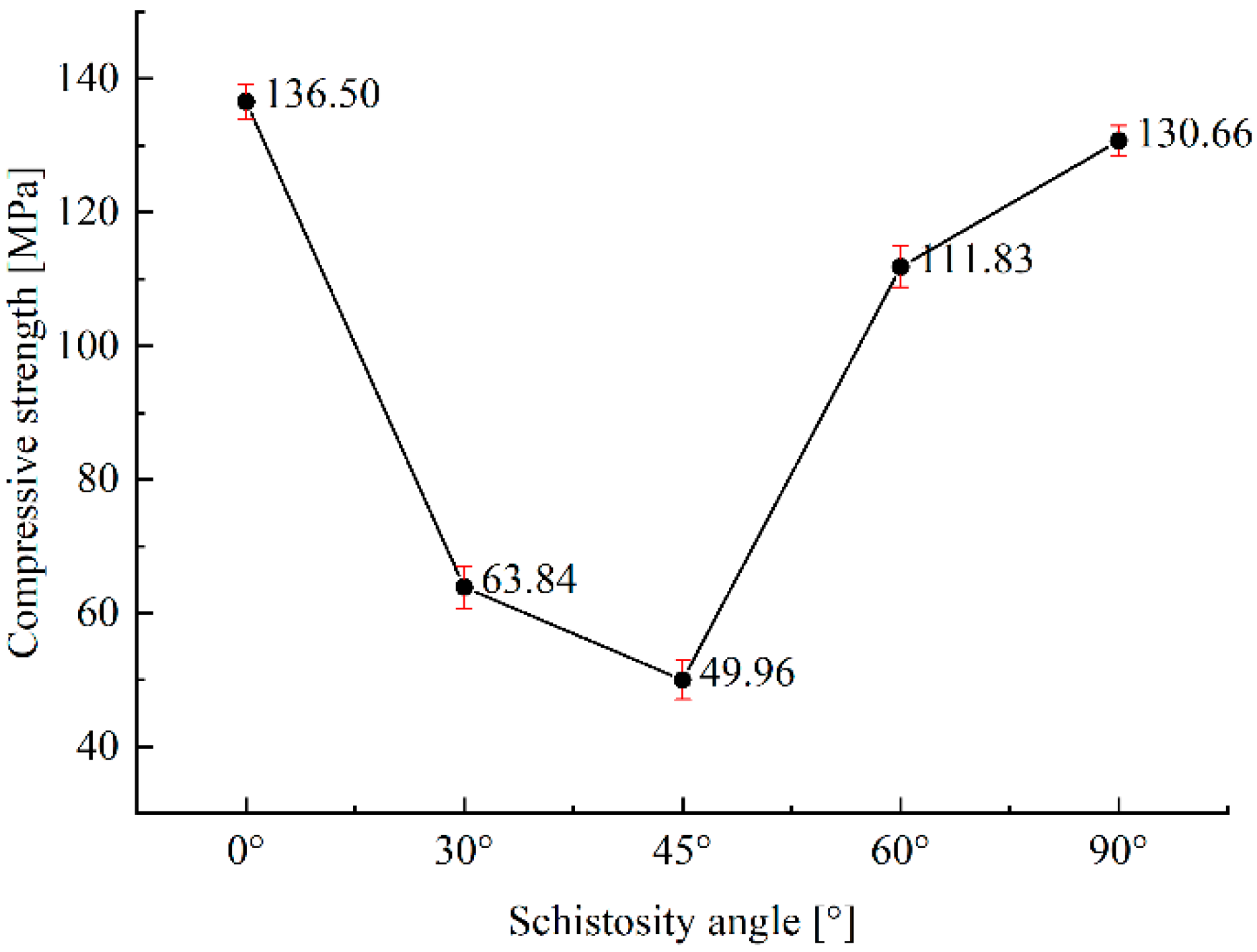
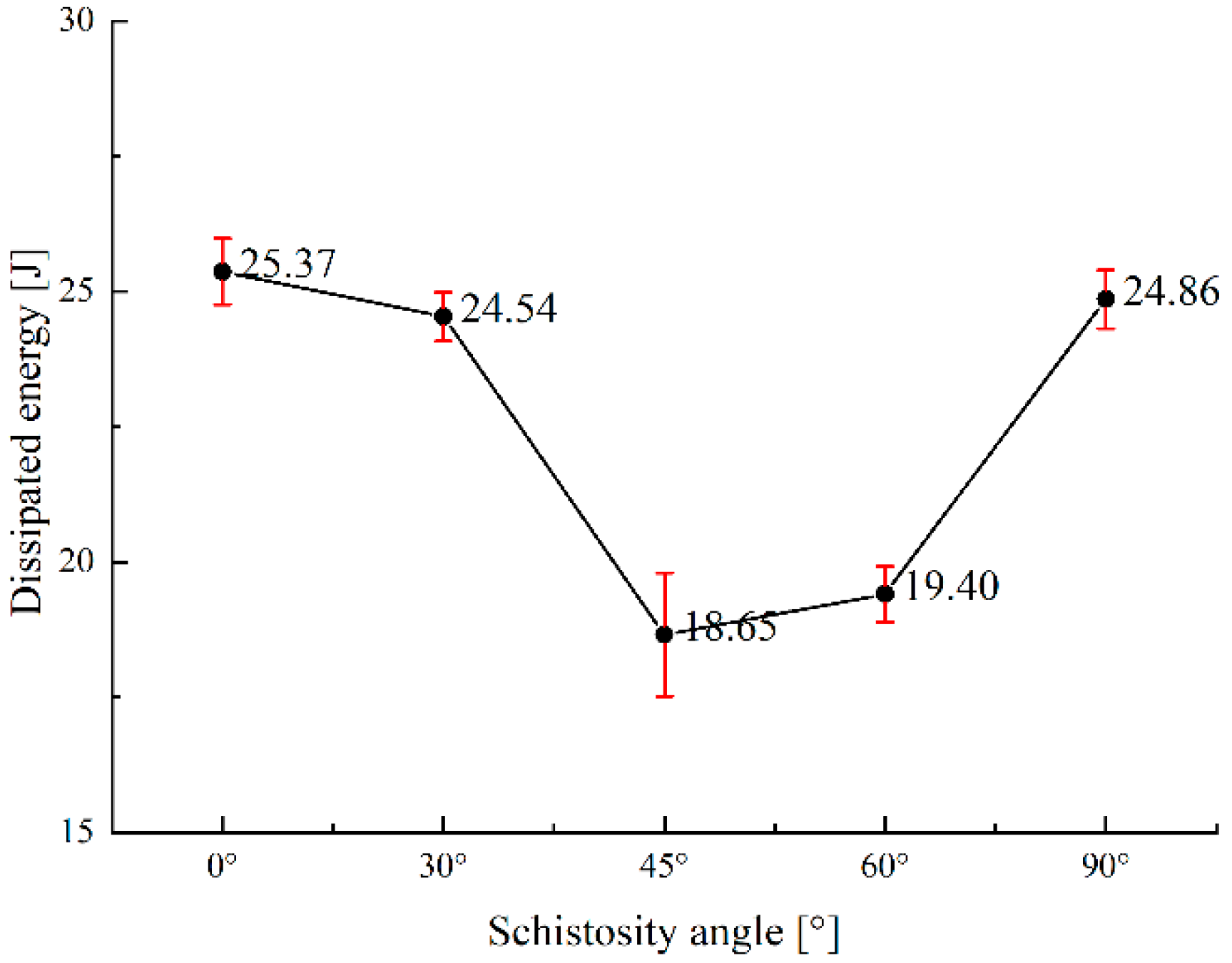
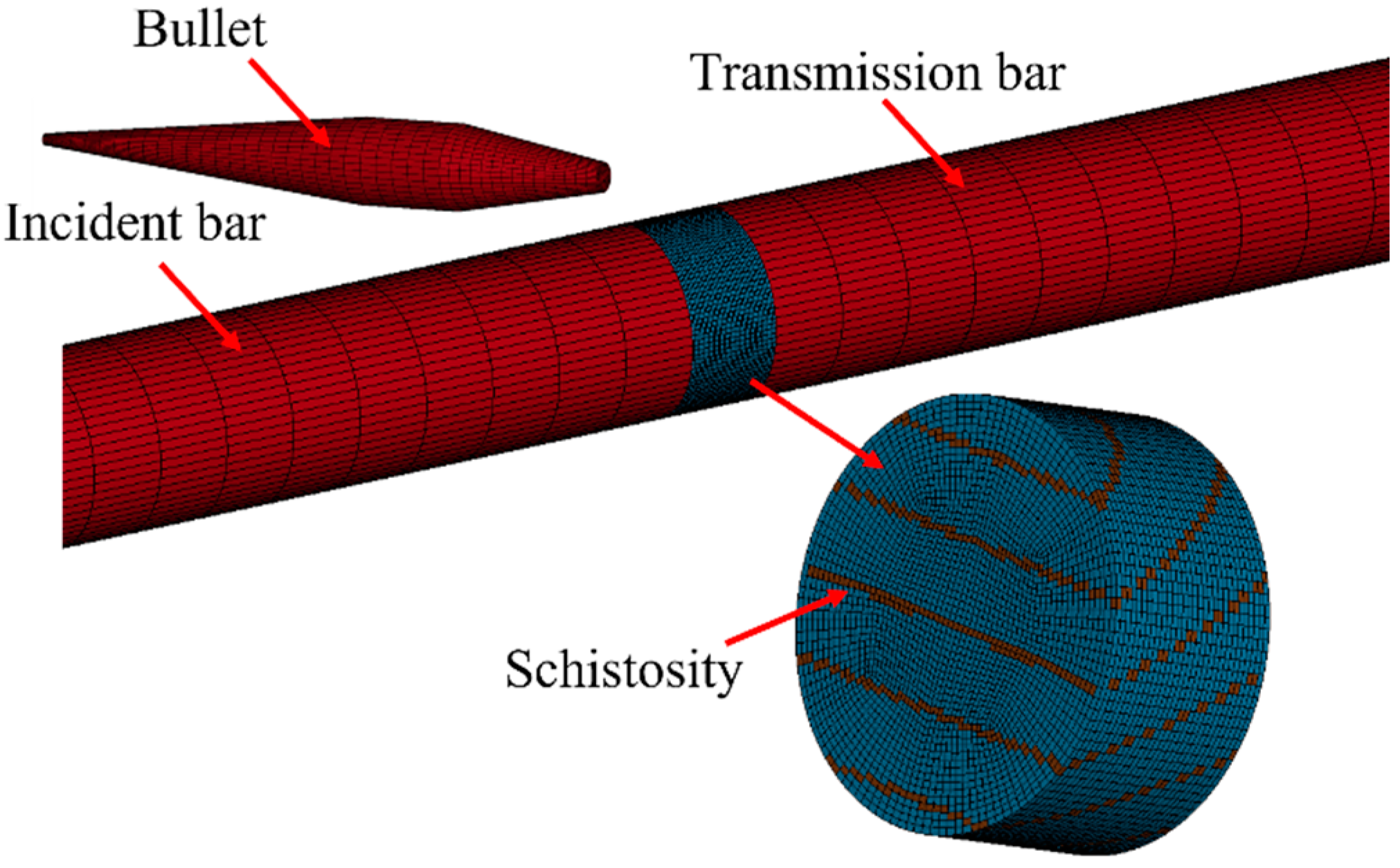
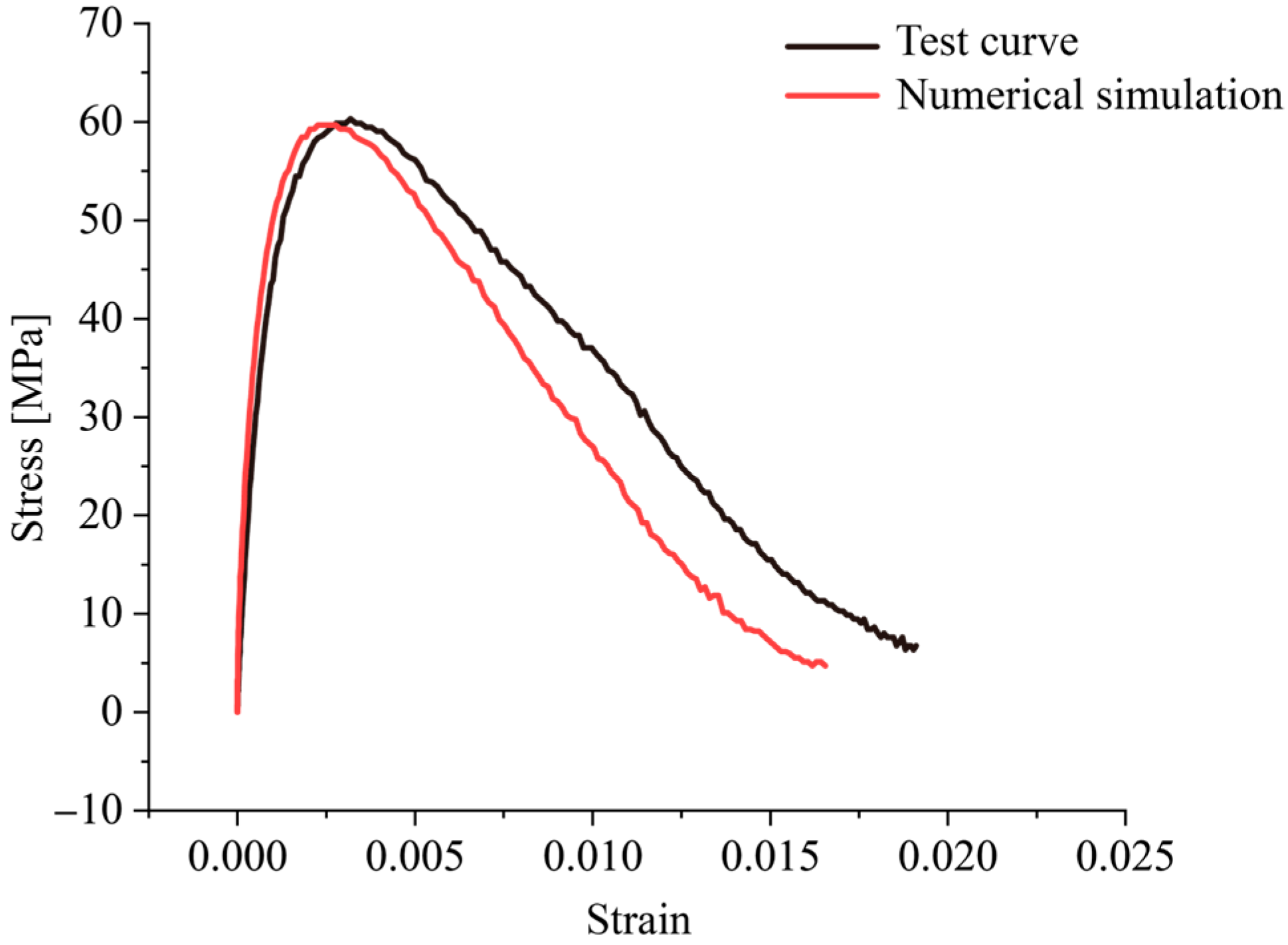

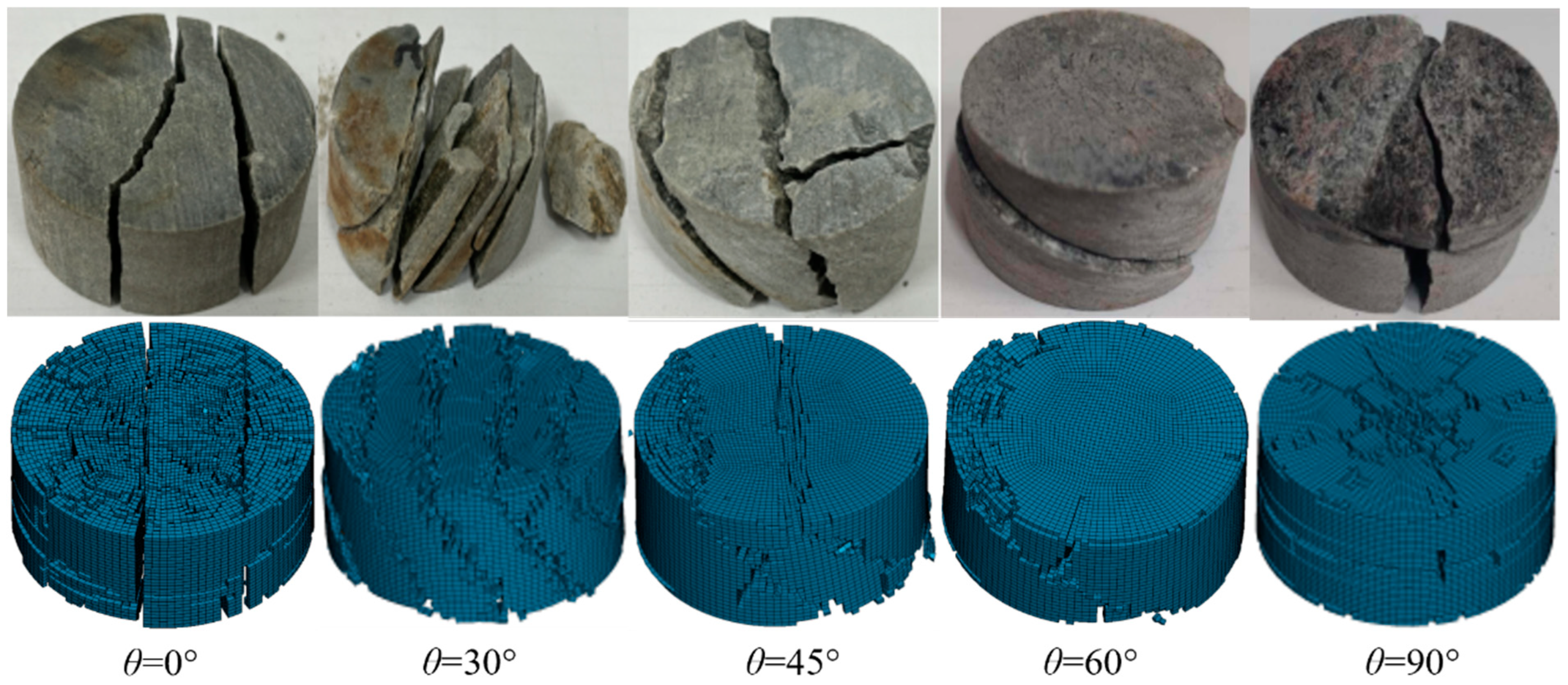


| No. | Schistosity Angle [°] | Volume [cm3] | Compressive Strength [MPa] | Incident Energy [J] | Reflection Energy [J] | Transmission Energy [J] | Dissipated Energy [J] | ||||
|---|---|---|---|---|---|---|---|---|---|---|---|
| Value | Mean | Standard Deviation | Value | Mean | Standard Deviation | ||||||
| A-0-1 | 0 | 49.04 | 133.89 | 136.50 | 2.63 | 74.45 | 2.99 | 45.84 | 25.62 | 25.37 | 0.61 |
| B-0-1 | 0 | 49.08 | 136.46 | 76.23 | 3.41 | 48.15 | 24.67 | ||||
| C-0-1 | 0 | 49.10 | 139.16 | 74.78 | 3.67 | 45.29 | 25.82 | ||||
| A-30-1 | 30 | 49.07 | 60.29 | 60.29 | 3.14 | 72.82 | 33.84 | 14.36 | 24.62 | 24.54 | 0.450 |
| B-30-1 | 30 | 49.10 | 64.99 | 73.82 | 36.21 | 14.56 | 24.05 | ||||
| C-30-1 | 30 | 49.03 | 66.25 | 72.45 | 35.67 | 14.84 | 24.94 | ||||
| A-45-1 | 45 | 49.06 | 47.20 | 49.96 | 2.90 | 67.88 | 28.81 | 19.16 | 19.91 | 18.65 | 1.13 |
| B-45-1 | 45 | 49.04 | 49.68 | 66.76 | 29.06 | 19.34 | 18.36 | ||||
| C-45-1 | 45 | 49.11 | 52.99 | 68.06 | 27.56 | 22.78 | 17.69 | ||||
| A-60-1 | 60 | 49.06 | 108.37 | 111.83 | 3.07 | 84.25 | 13.67 | 50.79 | 19.79 | 19.40 | 0.51 |
| B-60-1 | 60 | 49.13 | 112.86 | 83.39 | 14.34 | 49.45 | 19.60 | ||||
| C-60-1 | 60 | 49.09 | 114.26 | 86.45 | 16.16 | 51.52 | 18.82 | ||||
| A-90-1 | 90 | 49.06 | 128.33 | 130.66 | 2.26 | 98.45 | 13.78 | 59.65 | 25.43 | 24.86 | 0.54 |
| B-90-1 | 90 | 49.10 | 130.82 | 96.28 | 13.06 | 58.43 | 24.79 | ||||
| C-90-1 | 90 | 49.02 | 132.85 | 96.77 | 12.98 | 59.44 | 24.35 | ||||
| ρ | G | A | B | C | N | Fc |
|---|---|---|---|---|---|---|
| 2.711 | 0.068 | 0.462 | 1.950 | 0.240 | 0.83 | 4.22 × 10−4 |
| T | EPS0 | EFmin | Smax | Pcrush | μcrush | Plock |
| 5.31 × 10−5 | 1.00 × 10−6 | 0.01 | 5 | 1.41 × 10−4 | 0.00137 | 0.012 |
| μlock | D1 | D2 | K1 | K2 | K3 | Fs |
| 0.013 | 0.04 | 1 | 0.279 | 0.374 | 0.193 | 0.5 |
Disclaimer/Publisher’s Note: The statements, opinions and data contained in all publications are solely those of the individual author(s) and contributor(s) and not of MDPI and/or the editor(s). MDPI and/or the editor(s) disclaim responsibility for any injury to people or property resulting from any ideas, methods, instructions or products referred to in the content. |
© 2024 by the authors. Licensee MDPI, Basel, Switzerland. This article is an open access article distributed under the terms and conditions of the Creative Commons Attribution (CC BY) license (https://creativecommons.org/licenses/by/4.0/).
Share and Cite
Peng, Y.; Du, Z.; Chen, P.; Yao, Y.; Liu, G.; Wu, L. Study on Dynamic Mechanical Properties and Failure Pattern of Thin-Layered Schist. Appl. Sci. 2024, 14, 9101. https://doi.org/10.3390/app14199101
Peng Y, Du Z, Chen P, Yao Y, Liu G, Wu L. Study on Dynamic Mechanical Properties and Failure Pattern of Thin-Layered Schist. Applied Sciences. 2024; 14(19):9101. https://doi.org/10.3390/app14199101
Chicago/Turabian StylePeng, Yaxiong, Zehui Du, Peng Chen, Yingkang Yao, Guangjin Liu, and Li Wu. 2024. "Study on Dynamic Mechanical Properties and Failure Pattern of Thin-Layered Schist" Applied Sciences 14, no. 19: 9101. https://doi.org/10.3390/app14199101






